Analyzing Diamond Prices Per Carat in 2021
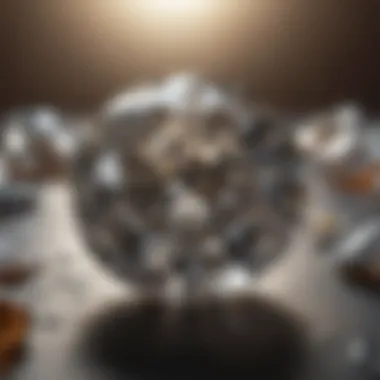
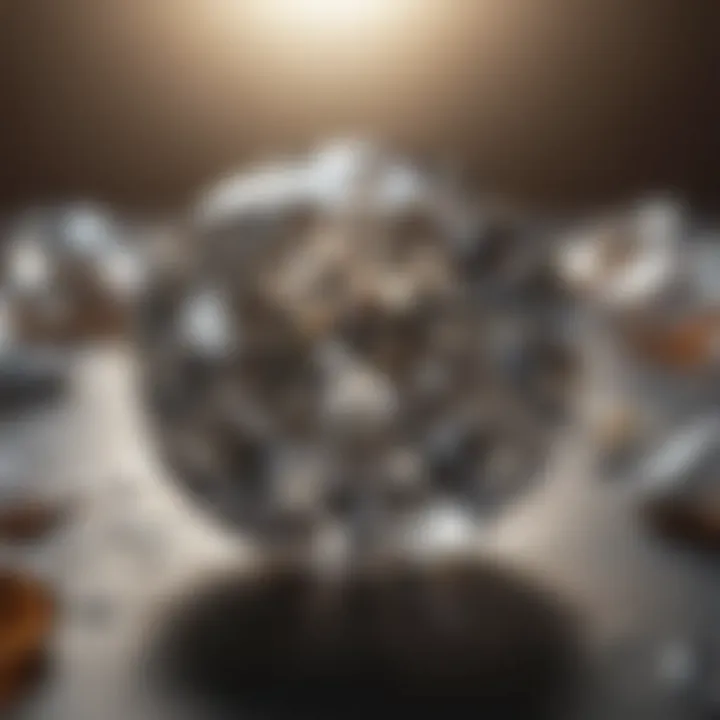
Intro
In discussing diamond prices per carat, the year 2021 stands out as a unique chapter in the narrative of the gemstone market. Understanding how prices fluctuated during this period requires us to look past the mere numbers and delve into the underlying factors that shaped the market. The interplay of quality, market conditions, and global economic influences provides a rich tapestry from which we can draw insight.
Diamonds have long been revered, and their allure is not merely confined to their brilliance. Their value is also dictated by a complex array of factors—some of which intertwine with cultural significance and consumer trends. As we explore each element that impacted diamond pricing in 2021, we set the stage for understanding their future trajectory.
Whether you are an ardent collector, a jewelry designer, or a casual enthusiast curious about the intricacies of the diamond world, it’s worth diving into the nuances of this precious stone. This thorough examination aims to clarify the dynamics at play, highlighting why certain trends emerged and what they might suggest for the years ahead.
Gemstone Overview
Definition and Characteristics
Diamonds are crystalline forms of carbon, renowned for their unmatched hardness and electric sparkle. Formed deep within the Earth under immense pressure and heat, their journey to the surface can take millions of years. The allure of diamonds lies not just in their physical properties but also in the stories they carry through culture and history.
Different grades of diamonds can be categorized primarily based on the Four Cs: carat weight, cut, color, and clarity. Each characteristic plays a crucial role in determining the diamond's overall value and visual appeal. Carat weight refers to the size of the diamond, while cut dictates how well the diamond reflects light, influencing its brilliance. Color ranges from colorless to shades of yellow and brown, with rarer colors driving prices even higher. Finally, clarity looks at the presence of inclusions or blemishes—flaws that can sometimes be visible to the naked eye.
Classification of Gemstones
While diamonds are a key focus, they are one among many gemstones. The classification of gemstones encompasses a variety of criteria. They can be categorized as precious or semi-precious, where diamonds, rubies, sapphires, and emeralds are often viewed as the elite ones. Moreover, one can consider other attributes such as rarity or cultural significance in their classification.
In the context of diamonds:
- Natural Diamonds: Formed through natural geological processes.
- Synthetic Diamonds: Man-made stones that mimic natural diamonds.
- Fancy Color Diamonds: Known for their vivid, surprising hues which can attract collectors willing to pay a premium.
With this groundwork laid, we can bridge into a more historical narrative, one that spotlights not only pricing trends but the myriad influences underpinning those figures.
Understanding Diamond Pricing
Understanding diamond pricing is crucial for anyone venturing into the world of gemstones. The value of a diamond isn't just a random number; it's a complex interplay of various factors that can sway prices dramatically. This article aims to dissect those elements, helping enthusiasts and collectors alike gain a clearer perspective on what drives price fluctuations. By grasping the fundamentals of diamond pricing, buyers can make more informed decisions, whether they are purchasing for investment, personal use, or as a gift.
The Four Cs of Diamonds
Each diamond's value is largely determined by the Four Cs: Cut, Color, Clarity, and Carat Weight. These characteristics are not just standard terminology; they are the backbone of diamond pricing, making them essential for understanding the stone's worth.
Cut
The cut of a diamond is perhaps one of the most important factors in its pricing. This refers to how well the diamond has been shaped and polished. A well-cut diamond not only sparkles beautifully but also reflects light in a way that maximizes its brilliance. The key characteristic here is the angle and proportions of the facets. A popular choice among buyers is the round brilliant cut due to its exceptional light performance. However, other shapes like cushion or emerald cuts can also offer unique aesthetics.
The unique feature of cut is that it can significantly alter the visual appeal of a diamond, making the price vary widely. For instance, a well-proportioned diamond can command a much higher price than one that is poorly cut, even if the two have similar carat weights.
Color
When talking about diamonds, color doesn't refer to the typical rainbow hues; it relates to how colorless or tinted a diamond is. The grading scale ranges from D (colorless) to Z (light yellow). The key point here is that color affects desirability. A colorless diamond is often seen as highly desirable, resulting in higher market prices.
What makes color intriguing is that even slight variations can lead to drastic price changes. A D-colored diamond may round up thousands more than a G-colored one, even though they may look similar to the untrained eye. Thus, understanding color is pivotal in assessing a diamond's value.
Clarity
Clarity examines the internal and external flaws, known as inclusions and blemishes, present in the diamond. A diamond with minimal imperfections will hold a higher price tag. The key characteristic of clarity is that even minute flaws can have large impacts on pricing; for instance, an eye-clean diamond will be worth much more than one that exhibits visible inclusions.
This brings an interesting dynamic to the clarity criteria; diamonds are often available at various price points depending on clarity grades. Some collectors prioritize clarity above all, making this a crucial element to consider when appraising a diamond's worth.
Carat Weight
Carat weight refers to the size of the diamond, and it's a critical factor in determining price. Generally speaking, the larger a diamond, the more expensive it is. However, it’s essential to note that the pricing doesn’t increase linearly with carat weight. For instance, a two-carat diamond typically costs significantly more than two one-carat diamonds due to its rarity.
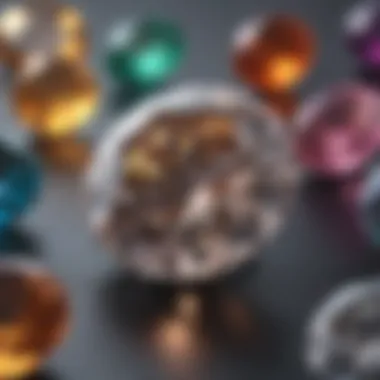
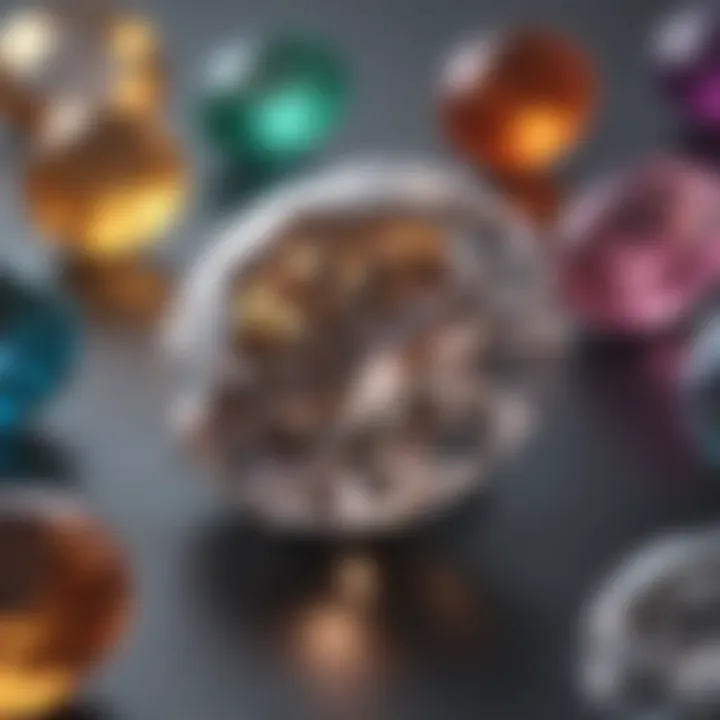
The unique aspect of carat weight is that it can also influence how other Cs are perceived. A heavier diamond might appear less desirable if it's poor in cut or clarity. Thus, when valuing diamonds, it’s vital to look at all Four Cs collectively, not just in isolation.
Market Forces Impacting Prices
As diamonds are not just jewelry pieces but commodities as well, various market forces come into play, shaping their prices. Understanding these market dynamics is essential for anyone aiming to navigate the diamond buying process effectively.
Supply and Demand Dynamics
The balance between supply and demand plays a pivotal role in determining diamond prices. When there are more buyers than available diamonds, prices invariably rise. Conversely, if the market is saturated with diamonds and demand drops, prices can tumble. This characteristic allows for fluctuations based on various external factors, such as economic conditions and trends in consumer behavior.
For instance, a sudden rise in demand for engagement rings can push prices up significantly, especially in markets where diamonds are scarce. So, knowing the supply-demand mechanics can provide valuable insights for potential buyers.
Global Economic Conditions
The global economy has a profound effect on diamond pricing as well. Economic downturns typically reduce discretionary income, which often leads to decreased demand for luxury items like diamonds. Conversely, during periods of economic growth, more individuals can afford to invest in high-value gemstones.
In 2021, various factors, including the lingering effects of the COVID-19 pandemic, played a crucial role in shaping the market. For instance, the shift in how people approached spending and investing as they navigated financial uncertainty was a significant contributor to the changes in diamond prices during this timeframe.
Consumer Trends
Lastly, looking at consumer trends gives vital insights into how and why diamond prices fluctuate. Shifts in trends can arise from cultural movements, changing values regarding engagements, or even the rise of alternative gemstones posing as competition. Young consumers today may prioritize ethical sourcing, which can affect their choices and the resultant pricing in the diamond market.
Diamond Price Trends
Understanding the diamond price trends in 2021 is crucial for anyone interacting with this market, whether for investment, personal adornment or other purposes. The year was marked by noticeable changes that can lead us to important insights. The shifts in diamond prices reflect a medley of forces at play, including market demands, quality distinctions, and spending behaviors influenced by the global economic climate. Analyzing these trends provides not only a snapshot of diamond valuation in that particular year but also serves as a litmus test for future expectations.
Average Price Per Carat
The average price per carat during 2021 revealed some interesting dynamics. Prices hovered around $6,000 to $7,500 per carat, a figure that indicates steadiness juxtaposed with the fluctuations caused by the pandemic. Shoppers sought quality over quantity, which ultimately nudged the average price up. This trend showcased that consumers were willing to spend more on finer gems as they arose from the uncertainties of the year prior.
Another factor worth noting was the changing landscape of luxury spending, notably due to rising disposable incomes in certain demographics. As high-net-worth individuals began to spend more, the average price per carat experienced upward pressure during 2021.
"In 2021, diamonds became a symbol of resilience and luxury, as buyers sought lasting value amidst unpredictability."
Price Variances by Quality
High-Quality Diamonds
Focusing on high-quality diamonds, these gems distinguished themselves with an exceptional clarity and a brilliant cut that tends to draw collectors and jewelry enthusiasts alike. The price for these diamonds can easily exceed $12,000 per carat due to the rarity and aesthetic qualities they possess. Such diamonds often captivate the eye and hold their value more firmly over time, making them a preferred choice among seasoned buyers.
High-quality diamonds are often regarded as a stable investment, possessing increased allure due to their unique features. However, buyers should remain aware that they may require a more substantial financial commitment. Those seeking high-quality stones can expect long-lasting returns. Despite that, the market can fluctuate, and values might sometimes dip.
Mid-Range Diamonds
Mid-range diamonds fall between the high and low ends of the spectrum, typically priced between $4,000 and $6,000 per carat. This price point appeals to a broad audience, from couples looking for engagement rings to gift-givers on special occasions. The clarity and cut quality in this category still offer a beautiful presentation, making these diamonds a balanced choice for consumers who want both quality and affordability.
While mid-range diamonds can be beautiful, buyers should take care in their evaluations. The features of these stones may vary significantly, largely based on individual characteristics. Some may indeed offer good value; others might not retain their price point as firmly due to market competition.
Low-Quality Diamonds
On the contrary, low-quality diamonds generally hold a price below $4,000 per carat. They may appeal to price-sensitive buyers who prioritize budget over quality. While these diamonds can be quite appealing visually in certain instances, they often come with slight imperfections that can affect their overall value and desirability.
The unique selling point for low-quality diamonds is their accessibility for those seeking to own a diamond without breaking the bank. However, it’s key to keep in mind that their investment potential isn’t typically as robust as higher-quality counterparts.
In summary, the divergences in quality lead to distinct categories that cater to varying depths of consumer interest and financial capabilities. The landscape remains broad, ensuring that there's an option for nearly any level of buyer in the diamond market.
Regional Price Differences
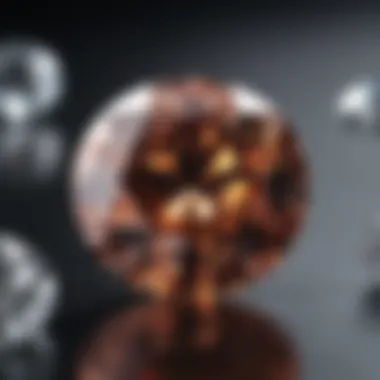

Understanding the regional variances in diamond prices is crucial for anyone looking to invest in or purchase these exquisite gemstones. Different geographical markets reflect unique consumer behaviors, supply chains, and economic conditions, all of which influence how diamonds are valued. Not only do these factors dictate local demand, but they also play a pivotal role in setting price expectations. This segment dives into the intricacies of how diamond prices can differ from one region to another, offering insights for both personal buyers and industry professionals alike.
North American Market
The North American diamond market stands out for its robust infrastructure, with major players like De Beers and various boutique sellers operating extensively. In 2021, this market saw a significant fluctuation in prices, particularly due to the ongoing effects of the global pandemic. Many consumers shifted their purchasing habits, gravitating towards online purchases rather than traditional brick-and-mortar retailers.
- Consumer Preferences: Buyers displayed a growing preference for high-quality diamonds, influencing the types of diamonds that saw increased demand. Moreover, there was a notable trend toward ethically sourced stones, impacting pricing as consumers are often willing to pay a premium for certification and trendy cuts.
- Economic Influences: The economic atmosphere in North America, marked by recovery from the pandemic recession, played a role in consumer confidence. Individuals investing in diamonds for both personal and financial reasons increased, triggering notable price dynamics.
European Market Trends
In Europe, the diamond market reflected a mixed bag of trends in 2021. While some countries were recovering faster than others, pricing remained relatively stable overall but varied significantly from one nation to another. The market is informed by historical significance, luxury branding, and regional cultures that influence purchasing decisions.
- Cultural Impact: Countries like Belgium and the UK are known for their heritage in diamond cutting and trading. As a result, diamonds from these regions may command higher prices due to perceived value and craftsmanship.
- Brexit Effects: The implications of Brexit also reshaped the market. While some feared negative impacts, certain luxury goods, including diamonds, maintained strong demand in post-Brexit Britain, reflecting a potential opportunity for price stability within the high-end market.
Asian Market Insights
Asia's diamond market is rapidly evolving, with countries such as India and China asserting themselves as major players. In 2021, significant growth in middle-class spending fueled demand for luxury items, including diamonds.
- Emerging Middle Class: As more consumers in Asian markets gain disposable income, the appetite for diamond jewelry has grown. Buyers are not only looking for engagement rings but also fashion pieces, increasing overall market demand and influencing pricing.
- Technological Enhancements: The rise of e-commerce platforms in Asia has made it easier for consumers to purchase diamonds online, amplifying competition and potentially affecting prices. This market's burgeoning tech sector enabled better access to information, allowing consumers to compare prices easily and make informed decisions.
"Regional differences in diamond pricing not only highlight local economic conditions but also reflect cultural preferences and consumer behaviors that shape the industry on a global scale."
In summary, understanding the regional disparities in diamond prices offers valuable context for buyers and investors alike. Each market tells a story driven by local factors, international trends, and economic currents, ultimately shaping the journey of these precious stones from mine to marketplace.
Influence of Online Retail on Pricing
In recent years, the retail landscape has shifted dramatically, particularly in the diamond market. The influence of online retail has revolutionized how diamonds are priced and sold. With the advent of e-commerce, traditional brick-and-mortar stores are no longer the sole gatekeepers of this precious gemstone. This change carries significance not only for sellers but also for buyers—especially for those who are looking for the best deals.
One major aspect to consider is the convenience of shopping online. Buyers can browse an extensive range of diamonds from the comfort of their homes, comparing prices across multiple retailers without breaking a sweat. This increased accessibility is a double-edged sword; while it benefits consumers through competition, it also means that retailers have to be vigilant about pricing their stones competitively.
The online retail environment has leveled the playing field, making it possible for smaller retailers to compete with industry giants. However, it has also spurred the emergence of price transparency, as consumers become more informed about market rates. This transparency results in customers having more leverage when negotiating and purchasing diamonds. Additionally, an array of online resources, such as reviews and price comparison tools, have made it easier for consumers to assess their options and ever more critical for vendors to establish trustworthiness.
Moreover, online retailers often operate with lower overhead costs than traditional stores, enabling them to pass on savings to customers. These price advantages can shift market pricing dynamics considerably.
"As the online shopping phenomenon continues to expand, we might witness even sharper fluctuations in diamond prices as competition drives down margins and increases value for consumers."
In summary, the influence of online retail on diamond pricing has brought a mix of benefits and challenges. It has empowered buyers, made shopping easier, and fostered competition, all of which contribute to a more dynamic marketplace.
E-Commerce Growth in the Diamond Sector
The surge in e-commerce has had profound implications for the diamond sector. In 2021, more and more consumers turned to the internet for their diamond purchases, spurred by a range of factors such as the ongoing global pandemic and changing shopping habits. With the rise in web-based sales, the diamond industry has found itself at a crossroads. Traditional retail models are being forced to reevaluate their strategies or risk being left behind in the dust.
- High-definition online imagery allows consumers to scrutinize details far better than any physical store ever could.
- Platform innovations, including augmented reality technology, have entered the fray, enabling customers to visualize how stones might look in jewelry settings, which can uplift buyer confidence.
As a consequence, there’s an influx of new entrants into the space, bringing diverse products and price points. Some boutiques may sell ethically sourced stones while others provide customizable options, appealing to varying tastes and preferences. This diversification is attractive to a younger consumer base that values unique offerings.
Impact of Online Competitors
The presence of online competitors has reshaped the dynamics of the diamond market. Notably, companies like Blue Nile and James Allen have altered consumer expectations with their straightforward and easy pricing structures, flexible payment options, and user-friendly platforms. The focus on online sales has resulted in a notable shift from conventional in-store engagement to a more informative and enjoyable digital shopping experience.
- Transparency in pricing is now expected. Buyers want to know exactly what they’re paying for and why. This need for clarity has shifted the paradigm, as consumers no longer accept vague pricing models.
- Competitors have adopted advanced algorithms to provide real-time pricing based on market conditions, making ordinary stone prices fluctuate in sync with demand and supply metrics. This phenomenon introduces an additional layer of complexity, requiring both sellers and buyers to remain updated on market trends.
The competition drives innovation—vendors must not only match prices but also differentiate themselves through customer service, quality guarantees, and return policies. Ultimately, failure to adapt may lead to a swift downturn in sales as more savvy consumers prioritize their choices based on value and experience.
In this evolving landscape of diamond pricing, adaptability is key. As online retail continues to grow, players in the market must be prepared to navigate a terrain where traditional pricing strategies may no longer hold sway.
Investment Trends in Diamonds
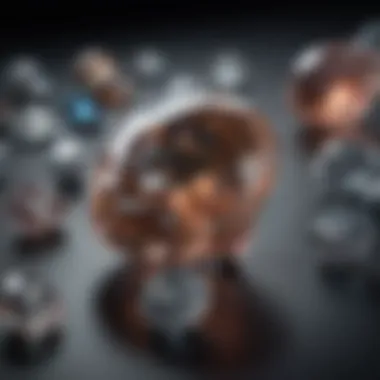
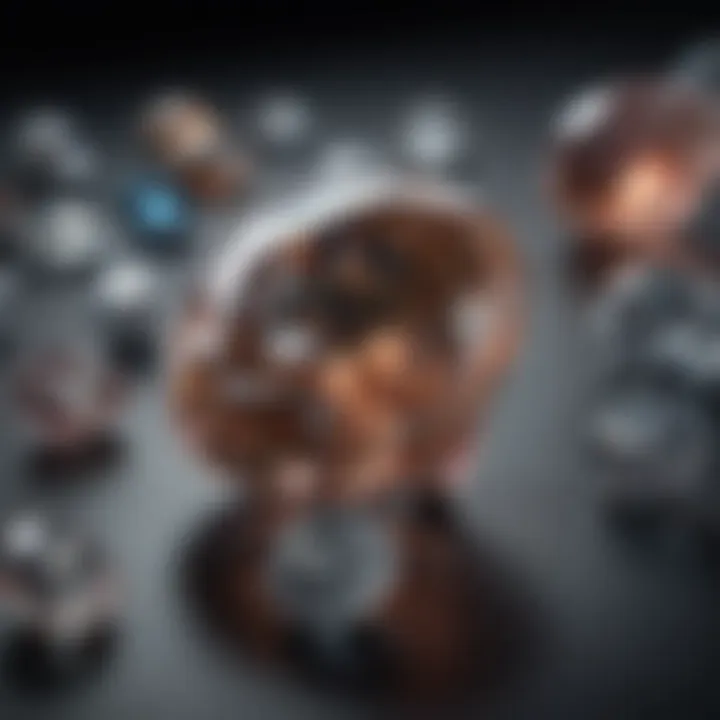
Understanding investment trends in diamonds is crucial for anyone who’s even mildly interested in the gem market. With fluctuating prices and economic uncertainties, diamonds are not just pretty stones; they’re often seen as a powerful asset in an investment portfolio. Investors need to navigate through various dynamics that influence the diamond market to make informed decisions.
Diamonds as Financial Assets
Diamonds have long been cherished not just for their beauty but as solid financial assets. They offer a unique attraction for investors looking to diversify their portfolios. Unlike stocks or bonds, diamonds are tangible assets. Here are some key points to consider when looking at diamonds as financial assets:
- Intrinsic Value: Diamonds hold intrinsic value which can appreciate over time. The rarity and demand for diamonds mean that a well-maintained stone can fetch a handsome price down the line.
- Portability: They are easily transportable compared to other heavy investments like real estate. This makes them a convenient option for global investors.
- Market Stability: Despite fluctuations, the diamond market has shown resilience. Even during economic downturns, many individuals still opt for diamonds as gifts or investments, which keeps demand alive.
However, potential investors must be aware of considerations like pricing transparency. Unlike other markets, the diamond industry's pricing can often feel obscure, which makes it essential to do thorough research before diving in.
Long-Term Value vs. Short-Term Fluctuations
When considering diamonds as an investment, the discussion often pivots to the balance between long-term value and the short-term fluctuations that can impact pricing. Many investors might be tempted to chase quick profits by flipping diamonds, but this could prove to be a risky endeavor. Here’s why:
- Long-Term Appreciation: Historically, diamonds have appreciated in value over an extended period. The right choice in terms of quality, sourced from reputable dealers, can result in a significant return on investment over time.
- Market Volatility: In the short term, diamond prices can be influenced by numerous factors like global economic conditions, changing consumer trends, and even shifts in mining regulations. Investors may see value dip or rise quickly, creating an environment where decisions must be made swiftly.
"The diamond market is a conundrum; its beauty often veils its volatility."
When making investment decisions, assessing personal risk tolerance is important. Individuals who might not wish to tie up significant capital for extended periods should consider engaging with diamonds as a part of a diversified investment strategy rather than a sole focus.
Future Predictions for Diamond Prices
Understanding the future of diamond prices is crucial for anyone connected to the gemstone market, whether they are buyers, sellers, or investors. It’s like trying to read tea leaves, one might say. These predictions rely on lots of moving parts, from economic indicators to social trends. Knowing where the market could be headed can help make informed decisions.
For gemstone enthusiasts and collectors, future price expectations could dictate when to buy or sell. Jewelry designers might need to consider these trends when planning collections. Additionally, investors looking into diamonds for financial growth should be aware of potential market shifts. In essence, keeping an eye on predictions is an essential part of the diamond ecosystem.
Emerging Markets and Their Impact
Lately, emerging markets have been shaking things up in the diamond world. Take India and China as prime examples. As these economies grow, so does the appetite for luxury goods, including diamonds.
These regions bring in new buyers who may not just be looking for the traditional engagement rings. They could be after statement pieces with the latest designs or unique, ethically sourced stones. So what does this mean for pricing?
- Increasing Demand: As new middle classes develop in these countries, more consumers can afford luxury items. Increased demand can push prices higher.
- Cultural Shifts: In many emerging markets, diamonds may carry different cultural significance than in the West, potentially influencing purchasing behaviors and market dynamics.
- Supply Chain Adjustments: As demand rises, supply chains might become strained, leading to fluctuations in prices. Keeping an eye on how these markets evolve is vital for understanding future price trajectories.
Technological Advances in Mining and Sales
Innovation in technology is also playing a key role when it comes to the diamond industry. From mining practices to online retail, advancements can add a twist to price predictions.
For example, modern extraction methods from places like Canada and Botswana are becoming more efficient. Techniques like high-resolution imaging and automated sorting ensure that diamonds extracted are of higher quality and require less time to process. This efficiency can stabilize supply and potentially lead to more consistent pricing.
When it comes to sales, e-commerce has completely changed how diamonds are sold. Online marketplaces allow buyers access to a wider range of products. This situation encourages competition amongst sellers, which often results in better prices for consumers.
Epilogue: The Market Landscape
The conclusion serves as a capstone to the exploration of diamond pricing in 2021, tying together the various threads weaved throughout the article. It highlights not only the important findings but also the broader implications for anyone in the diamond market, whether buyer, seller, or enthusiast. Understanding the landscape of 2021 is crucial in navigating future market behaviors and trends.
This past year has shown how resilient and adaptive the diamond market can be, reflecting fluctuations in consumer behavior, economic conditions, and technological advancements. The analysis of pricing trends, the regional variances, and the influence of e-commerce presents a clear picture of a market that is evolving yet rooted in traditional values of beauty and rarity. It's these elements that combine to give diamonds not just their monetary value, but also cultural significance.
In summarizing the key observations, we can grasp a sharper insight into how the diamond industry reacted to the peculiarities and challenges of 2021. For instance, the integration of online retail channels became a vital artery for sales, especially during pandemic restrictions. This digital shift was coupled with insights from the investment trends that indicated growing interest in diamonds as financial assets, steering collectors and investors alike to contemplate the stability that these gems offer amid economic uncertainty.
Key Takeaways from
- Steady Rise in Prices: Throughout 2021, diamond prices exhibited a gradual hike, showing signs of resilience against global economic downturns. This was particularly evident in high-quality stones, which maintained or even increased their value.
- Regional Variations Matter: Different markets experienced contrasting trends. North America and Asia tended to show more vigorous demand, impacted by local economic recoveries, while European buyers were more cautious.
- Investment Appeal: Diamonds are not just luxury items; they are increasingly seen as viable investment vehicles. The trend of viewing diamonds through a financial lens is gaining traction as the market proves its potential for long-term appreciation.
- Digital Transformation: E-commerce has changed the way consumers buy diamonds. Retailers who embraced online platforms saw significant boosts in sales, pointing toward a shift in how diamonds are marketed and sold in the future.
Understanding these key points prepares potential buyers and enthusiasts for what lies ahead.
Implications for Future Purchasing Decisions
As we look to the future, the insights garnered from the 2021 diamond market landscape offer invaluable guidance for purchasing decisions. First off, buyers should recognize that investing in diamonds can yield returns, but such investments require careful market analysis and awareness of the specific characteristics that drive prices.
- Quality Over Quantity: Just because a diamond has an appealing price does not mean it’s a sound investment. The focus should shift towards acquiring high-quality stones, which, as noted, have proven to retain and appreciate in value more reliably.
- Market Awareness: Keeping an eye on both local and global economic indicators can offer predictive insights into when to buy or sell. Awareness of regional trends can yield significant advantages.
- Digitally Savvy Shopping: Educating oneself on online market platforms is essential. The buyer should feel comfortable researching, comparing, and potentially purchasing through these channels, ensuring that they are tapping into the most competitive prices available.
- Long-Term Commitment: Diamonds are not typically short-term assets. Potential buyers should view diamond purchases through a longer lens, taking into consideration emotional value along with monetary worth.
In summary, the 2021 landscape presents a dynamic picture, suggesting that with informed decision-making, both collectors and casual buyers can cultivate not just admiration but also financial benefit from their diamond investments.







